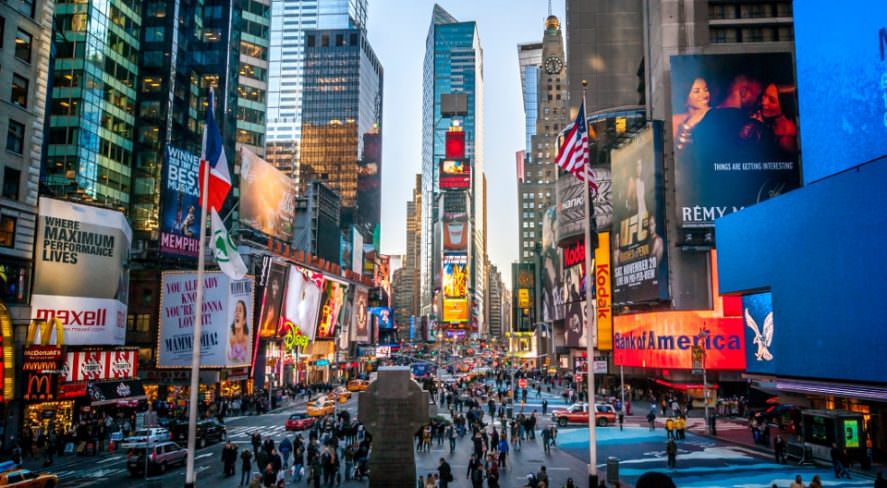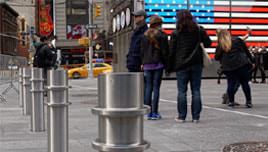SIA Member Saves Lives: Calpipe Bollards Halted Times Square Rampage

 Last week, a driver under the influence drove his car into Times Square in New York City, killing one person and injuring about 20 others. The incident was a chilling reminder of how vulnerable pedestrians are to a vehicle used as a weapon, an avowed tactic of terrorists seeking to kill or injure innocent bystanders.
Last week, a driver under the influence drove his car into Times Square in New York City, killing one person and injuring about 20 others. The incident was a chilling reminder of how vulnerable pedestrians are to a vehicle used as a weapon, an avowed tactic of terrorists seeking to kill or injure innocent bystanders.
In the case of Times Square on May 18, the speeding car was stopped by bollards, security posts strong enough to halt the heavy projectile. Those bollards were manufactured by Calpipe Security Bollards (CSB), a division of Calpipe Industries Inc. and a new member of the Security Industry Association (SIA).
Based in Rancho Dominguez, California, CSB offers a trusted line of high security, access control and architectural bollards. Since 1998, CSB has manufactured of perimeter security products in its Southern California facility, where the company adheres to strict engineering specifications and proven standards, said Dylan Markus, CSB Marketing Communications Manager.
In 20 years of operation, CSB gained a great deal of experience providing perimeter security products for a range of clients, including embassies, sports arenas, tourist attractions, military bases, and government facilities, among others, in search of high security barriers to defend against vehicular attacks or accidents.
“Those experiences and engineering lessons were very valuable in working through the unique Times Square requirements with New York City officials and other stakeholders,” said Markus.
Rob Reiter, co-founder of Storefront Safety Council (another SIA member), supports CSB as a security consultant. He told the Associated Press that New York City installed 200 customized bollards around Times Square. Those bollards, made of metal embedded in the ground, measure 8.5 inches in diameter, spaced about 4 feet apart.
CSB worked with New York City, the Times Square Alliance, and the New York Police Department and Fire Department New York to design the bollards project. It implemented the design with partners including architecture firm Snohetta, security consultants at LiRo Group, and Tully Construction, CSB reported.
The threat of terrorists using cars or trucks as massive missiles to kill or injure people became highly visible in battleground countries like Iraq and Afghanistan since 2001. In those nations, terrorists will often equip their vehicles with explosives, producing a vehicle-borne improvised explosive device, or VBIED. Lone wolves have adapted the tactic in civilian environments, often without explosives, such as in the case of an attack in London near Parliament in March.
VBIEDs require some special considerations, and CSB produces different bollards for different circumstances, Markus said.
“Generally speaking, terrorists want to use their vehicles to get their explosives as close to the target as possible,” he said. “The challenge with Times Square is that the target is people, and that area is one of the most heavily pedestrian-saturated locations in the world. Our bollards weren’t necessarily designed to prevent VBIED’s—they were designed to increase stand-off distances and prevent intentional vehicle attacks such as the one that occurred last week, whether terrorist-related or not.”
Reiter said the steel bollards could stop a 50,000-pound truck going at 50 mph, as demonstrated by crash testing. “The bollards worked as intended,” Reiter said.
The Times Square incident serves as a deadly reminder that traditional security measures, such as physical barriers deployed for perimeter security, still offer a great deal of utility in an age where security practitioners often discussed high-tech solutions like surveillance networks.
“Keeping people safe is where perimeter protection starts. Unless your perimeter is safe, your people aren’t safe. While security bollards may seem like a relatively traditional solution, Calpipe invests a lot of time and money into research and development to make sure that each and every one of our products will perform the way it was intended to,” Markus said.
For this, pedestrians in New York City and other crowded areas can be thankful.
Learn More
This topic was further explored in our archived webinar Stopping Vehicular Attacks: Protecting Against the Latest Terror Weapon.
The views and opinions expressed in guest posts and/or profiles are those of the authors or sources and do not necessarily reflect the official policy or position of the Security Industry Association (SIA).
